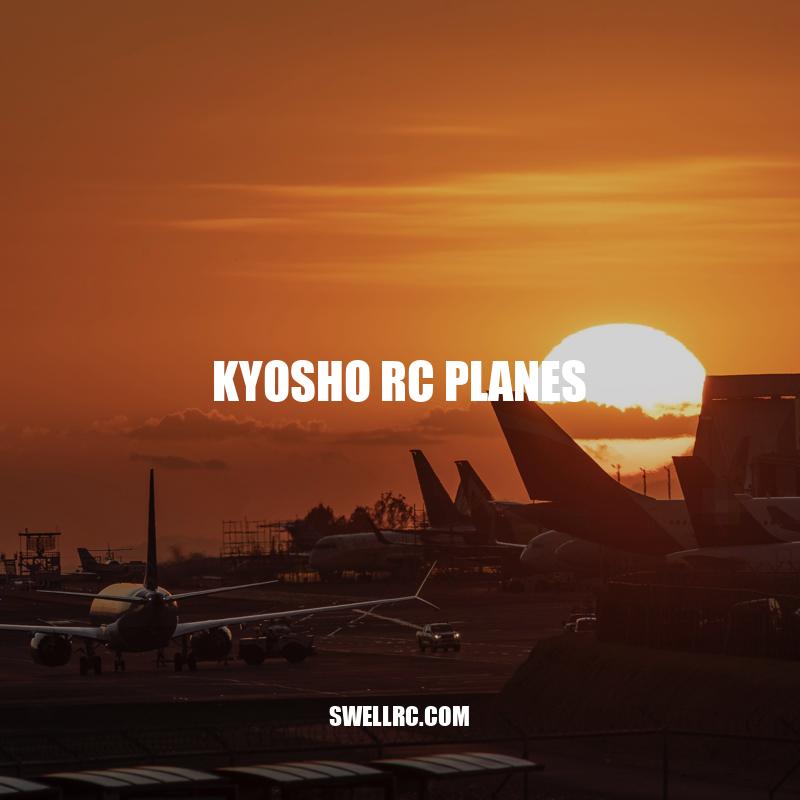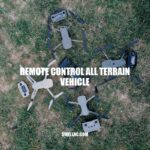Kyosho RC Planes: The Ultimate Guide
Kyosho RC planes are an exciting and popular remote control aircraft model that has captured the attention of aviation enthusiasts worldwide. These intricately designed models come in a range of sizes and styles, allowing pilots to choose a model that suits their interest and level of experience. The Kyosho brand is known for its quality of construction, attention to detail, and innovation in technology. Many Kyosho planes come preassembled, making it easy for beginners to get started and quickly progress onto more advanced models. For seasoned pilots, there are plenty of options to push their flying skills to the limit. Kyosho RC planes offer a great opportunity for pilots to engage in an exciting and fulfilling hobby that can provide hours of entertainment and a chance to connect with like-minded individuals. In this article, we’ll take a closer look at Kyosho RC planes and explore what makes them stand out from other remote control aircraft models in the market.
Kyosho RC planes are designed to provide a realistic and immersive flying experience, thanks to features like powerful brushless motors for increased speed, agility, and stability during flight, gyro stabilization that minimizes turbulence during takeoff, landing, and aerobatics, high-quality construction materials like lightweight balsa wood and carbon fiber that are durable and impact-resistant, and advanced remote controls with customizable radio settings, intuitive controls, advanced programming features, and more to suit your preferred flying style.
These features are combined to provide smooth and reliable flight, making Kyosho RC planes a favorite among pilots of all skill levels. Additionally, Kyosho RC planes come with different styles that cater to the different preferences of pilots. For example, micro and small planes are perfect for indoor flying, while larger models are perfect for big and spacious flying fields.
For those interested in purchasing Kyosho RC planes, there are many reputable online outlets such as Horizon Hobby and Tower Hobbies that offer a wide selection of models and accessories. Pilots can also find instructional videos and forums online to learn more about the planes and connect with other enthusiasts.
How many types of RC planes are there?
There are several types of radio-controlled (RC) planes, including trainers, sport planes, aerobatic planes, warbirds, and gliders. Each type is designed for a specific purpose, such as learning to fly, performing stunts, or participating in competitive events. To learn more about these types of RC planes and find products related to them, you can visit websites such as Horizon Hobby, Tower Hobbies, and RC Planet.
Kyosho RC planes are perfect for beginners who are interested in learning the art of flying. Here are some reasons why:
- Easy to fly planes with beginner-friendly and intuitive controls; perfect for those new to the hobby.
- Stable planes with gyroscopic technology that lessens the chances of a crash during takeoff and landing.
- Various models that match the preferences of new pilots. From simple to advanced, there’s a Kyosho RC plane that suits the needs of anyone looking to learn how to fly.
Kyosho RC planes also provide an excellent platform for beginners to learn the basics of aerobatics. The planes are designed to handle the stresses of advanced flying maneuvers and with practice, pilots can improve their skills and confidence in the air. Kyosho planes come equipped with remote controls that have different settings, making it easy to adjust the settings to match your flying style.
For new pilots, there are plenty of online tutorials and instructional videos available for free on websites like RC Groups and FlyingGiants. There are also online communities where pilots can connect with other enthusiasts and share tips and ideas on how to fly and maintain their Kyosho RC planes.
A Beginner’s Checklist for Flying Kyosho RC Planes
Here is a beginner checklist for flying Kyosho RC planes:
Tasks Details
1. Choose a plane Choose a plane that is designed for beginners, like a micro or small-size plane.
2. Perform a pre-flight check Check for any visible anomalies, ensure official regulations are met, check radio system, etc.
3. Find an open space Find a large and spacious flying field or indoor gymnasium to ensure adequate space during flight.
4. Assemble the plane Follow the assembly instructions that come with the plane to ensure proper setup and safety.
5. Learn the ropes and start flying Practice basic maneuvers like takeoff, landing, and turns. Get comfortable with the remote control settings and slowly work your way up to more advanced tricks.
How do you fly an RC plane for the first time?
Flying an RC plane for the first time can be intimidating, but with the right preparation and mindset, it can also be a lot of fun. Start by familiarizing yourself with your plane’s manual and controls. Find a large, open space with little to no wind and minimal obstacles or bystanders. Begin with simple maneuvers, such as takeoff and landing, before progressing to more advanced techniques. It’s important to be patient and take things slowly, as crashes are inevitable while learning. Consider joining an RC club for guidance and support, or watching online tutorials or instructional videos. Finally, always prioritize safety and follow local regulations when flying RC planes.
If you are looking for more information or to purchase an RC plane, websites such as HobbyKing, Horizon Hobby, and Tower Hobbies offer a wide range of options and resources for beginners.
Kyosho RC planes are not just for beginners; they’re also suitable for advanced pilots looking to take their flying experience to the next level. Here are some reasons why:
- Durable and high-performance planes designed to tackle advanced flying maneuvers and aerobatics
- Advanced technologies such as brushless motors and gyro stabilization for a more responsive and stable flight.
- Various models to choose from, including scale and sport planes, gliders, and jets.
Experienced pilots will find that Kyosho RC planes have many features that cater to their needs and help them achieve their flying goals. Here are some advanced flying tricks that Kyosho RC planes are capable of:
- Aerobatics such as loops, rolls, snap rolls, hammerheads, and inverted flight.
- 3D flying, which involves complex moves that are designed to test the limits of the pilot and the aircraft.
- FPV flying which involves flying the aircraft using a camera system that provides a real-time view of the plane’s surroundings.
To improve the advanced flying skills, there are many online resources available such as instructional videos, tutorials, and forums. Websites such as HobbyKing and RCGroups have active communities of experienced pilots who are willing to share their experiences and tips with newcomers to the hobby.
A Checklist for Advanced Pilots Flying Kyosho RC Planes
Here is a checklist for advanced pilots flying Kyosho RC planes:
- Inspect the plane before flying: check for any visible damages, flight system programming, balance, orientation, etc.
- Choose the right plane for your skill level: Select an aircraft that matches your advanced flying skills and preference for aerobatics, gliders, sport planes, or jets.
- Select a flying location: Find a large and spacious flying field or indoor gymnasium to ensure adequate space during flight that allows for advanced maneuvers.
- Practice before attempting difficult maneuvers: make sure to get comfortable with the aircraft and the remote control settings before attempting advanced tricks.
- Familiarize yourself with safety precautions: always have safety glasses, avoid flying near bystanders, and abide by official regulations.
How can I be a better RC pilot?
To become a better RC pilot, there are a few things you can do. Firstly, have a “throw around” airplane that you are comfortable practicing with. Additionally, don’t be afraid to push your limits and fly to crash – this will help you learn your limits and how to recover from mistakes. It’s also important to have spare airframes and practice landing to improve your skills. Flying different airplanes can also help you improve, as can buying extra batteries and taking multiple planes to the field. Finally, take the time to learn about aerodynamics and how your plane operates in the air. For more information and resources, there are several websites and products available, such as RCGroups.com and the book “The Beginner’s Guide to Flying RC Airplanes” by Terry Dunn.
Kyosho RC planes have a wide range of models that are perfect for aerial photography. Here are some reasons why Kyosho planes are perfect for aerial photography:
- High-quality cameras mounted on the planes that allow for aerial photography and videography from different vantage points.
- Advanced features such as video stabilization, high-resolution sensors, and remote control settings for easy operation and optimal results
- Durable and lightweight planes that can carry cameras without sacrificing performance or stability.
Some of the Kyosho models that are popular among aerial photographers include the Calmato Alpha 40 Sports EP/GP Blue and the Calmato Alpha 40 Sports EP/GP Red. These planes have a modular design that makes it easy to mount and dismount cameras quickly.
Aerial photography enthusiasts can also enjoy these features when using Kyosho RC planes:
- Stable in-flight operation, which results in sharp and smooth images and videos.
- A long flying time that ensures a more extended capability to capture footage.
- Remote operation for capturing difficult locations and the control of the camera without compromising the pilot’s flying experience.
When it comes to aerial photography using Kyosho planes, some resources that can help are drone sites such as Dronethusiast and Drone Catcher. These websites have forums and tutorials on how to use Kyosho RC planes for aerial photography, as well as reviews on the best cameras to use and the best planes to fly.
A Checklist for Aerial Photographers Flying Kyosho RC Planes
Here is a checklist for aerial photographers flying Kyosho RC planes:
| Tasks | Details |
|---|---|
| Choose the right camera for your needs | Consider features such as image stabilization, video resolutions, and multi-directional mounts. |
| Familiarize yourself with the rules and regulations | Make sure you comply with the local laws and regulations surrounding drone usage, flying restrictions, and privacy restrictions. |
| Choose the right flying location | Find a safe, sparsely populated and open area where you can fly away from people, buildings, and other potential hazards. |
| Prep your aircraft | Charge your batteries, make sure the camera is secure and balanced, and ensure your remote is equipped with a GPS for easy tracking and navigation. |
| Practice | Before taking the camera into the air, make sure you have practiced flying, setting the camera features, and controlling both the camera and aircraft. |
What is the best airplane for aerial photography?
The Cessna 172 Skyhawk, with its high wing, is one of the best choices for aerial photography. Low winged airplanes tend to limit the view below, and even with high wings, the wing strut can be obstructive to the view. However, aircraft modifications, such as window placements or different wing struts, can improve the view.
Kyosho RC planes require routine maintenance to optimize their performance and ensure longevity. Proper maintenance ensures the safety of the user and prolongs the life of the plane. To keep the plane in top shape, you have to clean it after every use, check it for damage and wear, replace any parts, calibrate the servos and other components, and store it correctly.
Cleaning the plane after use prevents dirt and debris from causing damage. Use a soft cloth or brush to gently remove dirt and debris from the plane’s exterior, and compressed air or a vacuum cleaner to clear debris from interior parts such as the motor, gearbox, and servos.
Checking the plane for damage is crucial. Check the plane’s wires and cables for damage or signs of fraying. Also, check for cracks, dents, or breakages on the plane’s exterior. Replace any propeller or rotor blades that are cracked or damaged, and any worn-out or damaged batteries, wires, cables, and other parts. Always use genuine Kyosho parts to ensure compatibility and safety.
Calibrating your plane’s servos and other components is essential to ensure it functions correctly. Make sure the servos and other mechanical parts are calibrated and in good working order. Always use the right tools and equipment to perform the necessary calibration and adjustments.
You must store your plane properly to prevent damage. Always store your plane in a clean and dry area. When not in use, remove the batteries to avoid battery drain, and use a carrying case or protective covering to avoid scratches, dents, or other damages to the plane.
Kyosho provides a comprehensive user manual with each plane that outlines the necessary maintenance procedures. In case of troubleshooting, Kyosho online customer service provides instant support.
In conclusion, Kyosho RC planes are a great investment for both beginners and advanced pilots who are interested in flying remote control airplanes. Regular maintenance of these planes helps increase their lifespan and improves performance while ensuring safety during use. Practice proper maintenance procedures, and your Kyosho RC plane will provide you with many hours of enjoyment.
Conclusion
Kyosho RC planes are one of the most sought-after remote control planes in the market today. They offer a vast range of airplanes that cater to the needs of different users, whether you are a beginner or an advanced pilot, an aerobatics enthusiast or an aspiring aerial photographer. With their advanced features, such as brushless motor technology and gyro stabilization, flying Kyosho RC planes is an exciting and enjoyable experience. Moreover, they are built from high-quality materials, making them durable and lightweight.
In conclusion, investing in a Kyosho RC plane is an excellent choice for anyone who enjoys flying remote control airplanes. With their range of models and features, they are suitable for enthusiasts of all skill levels, and they provide an excellent platform to learn flying techniques. However, like most electronic gadgets, regular maintenance is critical to keep your Kyosho RC plane flying smoothly. By following the necessary maintenance procedures outlined in the user manual, you can increase the lifespan of your plane and enjoy its performance for many years to come.



